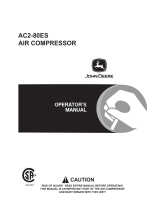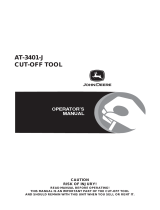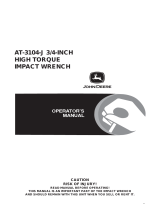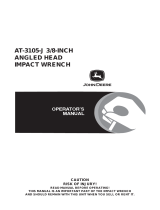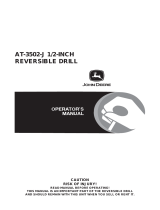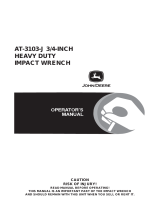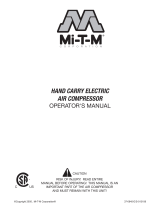Page is loading ...

Hand Carry Electric Air Compressor Manual 1
AC1-5E
AIR COMPRESSOR
CAUTION
RISK OF INJURY! READ ENTIRE MANUAL BEFORE OPERATING!
THIS MANUAL IS AN IMPORTANT PART OF THE AIR
COMPRESSOR AND MUST REMAIN WITH THIS UNIT!

2 Hand Carry Electric Air Compressor Manual
TABLE OF CONTENTS
INTRODUCTION ................................................................................................................3
IMPORTANT
..................................................................................................................3
INSPECTION ......................................................................................................................3
IMPORTANT SAFETY INSTRUCTIONS .........................................................................4-7
RISK OF ELECTRIC SHOCK OR ELECTROCUTION ................................................
4
RISK OF EXPLOSION OR FIRE .................................................................................5
RISK OF BURSTING ...................................................................................................5
RISK TO BREATHING .................................................................................................6
RISK OF BURNS .........................................................................................................6
RISK OF FLYING OBJECTS .......................................................................................6
RISK FROM MOVING PARTS .....................................................................................7
RISK FROM NEGLIGENCE .........................................................................................7
RISK OF AIR COMPRESSOR DAMAGE ....................................................................7
FEATURES DRAWINGS ....................................................................................................8
FEATURES REVIEW .........................................................................................................9
PREPARATION INSTRUCTIONS ....................................................................................
12
INITIAL SET-UP .........................................................................................................12
LOCATION .................................................................................................................12
ELECTRICAL .............................................................................................................12
PRE-START CHECKLIST ..........................................................................................12
OPERATING INSTRUCTIONS ........................................................................................
13
START-UP ..................................................................................................................13
SHUTDOWN ..............................................................................................................13
MAINTENANCE INSTRUCTIONS ...................................................................................13
TROUBLESHOOTING ................................................................................................14-17
WARRANTY .....................................................................................................................
18
NOTES .........................................................................................................................19-21

Hand Carry Electric Air Compressor Manual 3
IMPORTANT!
A "DANGER, WARNING or CAUTION" safety warning will be surrounded by a "SAFETY ALERT BOX".
This box is used to designate and emphasize Safety Warnings that must be followed when operating this
air compressor. Accompanying the safety warnings are "Signal Words" which designate the degree or
level of hazard seriousness. The "Signal Words" used in this manual are as follows:
DANGER: Indicates an imminently hazardous situation which, if not avoided,
WILL result in death or serious injury.
WARNING: Indicates a potentially hazardous situation which, if not avoided,
COULD result in death or serious injury.
CAUTION: Indicates a potentially hazardous situation which, if not avoided
MAY result in minor or moderate injury or damage to the air
compressor.
The symbols set to the left of this paragraph are "Safety Alert Symbols". These
symbols are used to call attention to items or procedures that could be dangerous
to you or other persons using this equipment.
ALWAYS PROVIDE A COPY OF THIS MANUAL TO ANYONE USING THIS EQUIPMENT. READ ALL
INSTRUCTIONS IN THIS MANUAL AND ANY INSTRUCTIONS SUPPLIED BY MANUFACTURERS OF
SUPPORTING EQUIPMENT BEFORE OPERATING THIS AIR COMPRESSOR AND ESPECIALLY POINT
OUT THE "SAFETY WARNINGS" TO PREVENT THE POSSIBILITY OF PERSONAL INJURY TO THE
OPERATOR.
INTRODUCTION
Congratulations on the purchase of your new Air Compressor! You can be assured your Air Compressor was
constructed with the highest level of precision and accuracy. Each component has been rigorously tested by
technicians to ensure the quality, endurance and performance of this air compressor.
This operator's manual was compiled for your benefit. By reading and following the simple safety, installation
and operation, maintenance and troubleshooting steps described in this manual, you will receive years of trouble
free operation from your new Air Compressor. The contents of this manual are based on the latest product
information available at the time of publication. The manufacturer reserves the right to make changes in price,
color, materials equipment, specifications or models at any time without notice.
Once the unit has been uncrated, immediately write in the serial number of your unit in the space provided
below.
SERIAL NUMBER_________________________________
Inspect for signs of obvious or concealed freight damage. If damage does exist, file a claim with the transportation
company immediately. Be sure that all damaged parts are replaced an that the mechanical and electrical problems
are corrected prior to operation of the unit. If you require service, contact your Customer Service.
Mi-T-M
®
Corporation, 8650 Enterprise Drive, Peosta, IA 52068
1-877-JD-KLEEN / (1-877-535-5336) Fax 563-556-1235
Monday - Friday 8:00 a.m. - 5:00 p.m. CST
Please have the following information available for all service calls:
1. Model Number
2. Serial Number
3. Date and Place of Purchase

4 Hand Carry Electric Air Compressor Manual
POTENTIAL CONSEQUENCE
PREVENTION
RISK OF
ELECTRIC SHOCK
OR
ELECTROCUTION
Serious injury or death could
occur if the air compressor is
not properly grounded. Your
air compressor is powered by
electricity and may cause electric
shock or electrocution if not used
properly.
Electrical shock may occur from
electrical cord.
Electrical shock may occur if
air compressor is not operated
properly.
Serious injury or death may occur
if electrical repairs are attempted
by unqualified persons.
Make sure the air compressor is
plugged into a properly grounded
outlet which provides correct
voltage and adequate fuse
protection. Disconnect when not
in use.
Check power cord for signs of
crushing, cutting or heat damage.
Replace faulty cord before use.
Keep all connections dry and off
the ground. Do not allow electrical
cords to lay in water or in such a
position where water could come
in contact with them. Do not touch
plug with wet hands.
Do not pull on the electrical cord to
disconnect from the outlet.
Never operate air compressor in
wet conditions or outdoors when it
is raining.
Never operate air compressor with
safety guards/covers removed or
damaged.
Any electrical wiring or repairs
performed on this air compressor
should be done by Authorized
Service Personnel in accordance
with National and Local electrical
codes.
Before opening any electrical
enclosure, always shut off the
air compressor, relieve pressure
and unplug the air compressor
from the power source. Allow air
compressor to cool down. Never
assume the air compressor is safe
to work on just because it is not
operating. It could restart at any
time! Service in a clean, dry, flat
area.
IMPORTANT SAFETY INSTRUCTIONS
WARNING: When using this product, basic precautions should always be observed, including the following:
READ ALL SAFETY INSTRUCTIONS BEFORE USING AIR COMPRESSOR
HAZARD

Hand Carry Electric Air Compressor Manual 5
RISK OF
EXPLOSION OR FIRE
POTENTIAL CONSEQUENCE
PREVENTION
Serious injury or death may occur
from normal electrical sparks in
motor and pressure switch
Serious injury may occur if any air
compressor ventilation openings
are restricted, causing the air
compressor to overheat and start
a fire.
Serious injury or death may occur
from an air tank explosion if air
tanks are not properly maintained.
Serious injury may occur from
an air compressor malfunction or
exploding accessories if incorrect
system components, attachments
or accessories are used.
Always operate air compressor
in a well ventilated area free of
flammable vapors, combustible
dust, gases or other combustible
materials.
DO NOT SMOKE if spraying
flammable material. Locate the air
compressor at least 20 feet away
from the spray area. (An additional
hose may be required.)
Never place objects against or on
top of air compressor. Operate air
compressor at least 12 inches away
from any wall or obstruction that
would restrict proper ventilation.
Drain air tank daily or after each use
to prevent moisture buildup in the air
tank.
If air tank develops a leak, replace
the air tank immediately. Never
repair, weld or make modifications to
the air tank or its attachments. Use
only genuine Manufacturer repair
parts for your air compressor.
Never make adjustments to the
factory set pressures.
Never exceed manufacturers
maximum allowable pressure rating
of attachments.
Because of extreme heat, do not
use plastic pipe or lead tin soldered
joints for a discharge line.
Never use air compressor to inflate
small, low pressure objects such as
toys.
RISK OF
BURSTING
IMPORTANT SAFETY INSTRUCTIONS
READ ALL SAFETY INSTRUCTIONS BEFORE USING AIR COMPRESSOR
HAZARD

6 Hand Carry Electric Air Compressor Manual
POTENTIAL CONSEQUENCE
PREVENTION
RISK TO
BREATHING
RISK
OF BURNS
RISK
OF FLYING OBJECTS
Serious injury or death could occur
from inhaling compressed air. The
air stream may contain carbon
monoxide, toxic vapors or solid
particles.
Sprayed materials such as paint,
paint solvents, paint remover,
insecticides, weed killers, etc.
contain harmful vapors and
poisons.
Serious injury could occur
from touching exposed metal
parts. These areas can remain
hot for some time after the air
compressor is shutdown.
Soft tissue damage can occur
from the compressed air stream.
Serious injury can occur from
loose debris being propelled at a
high speed from the compressed
air stream.
Never inhale air from the air
compressor either directly or from
a breathing device connected to
the air compressor.
Operate air compressor only in
a well ventilated area. Follow all
safety instructions provided with
the materials you are spraying.
Use of a respirator may be
required when working with some
materials.
Never allow any part of your body
or other materials to make contact
with any exposed metal parts on
the air compressor.
Always wear safety glasses to
shield the eyes from flying debris.
Never point the air stream at any
part of your body, anyone else or
animals.
Never leave pressurized air in
the air compressor. Shut off air
compressor and relieve pressure
when storing or attempting
maintenance.
Always maintain a safe distance
from people and animals while
operating the air compressor.
Do not move the air compressor
while air tank is under pressure.
Do not attempt to move the air
compressor by pulling on the
hose.
IMPORTANT SAFETY INSTRUCTIONS
READ ALL SAFETY INSTRUCTIONS BEFORE USING AIR COMPRESSOR
HAZARD

Hand Carry Electric Air Compressor Manual 7
POTENTIAL CONSEQUENCE
PREVENTION
RISK FROM
MOVING PARTS
RISK FROM
NEGLIGENCE
RISK
OF AIR COMPRESSOR
DAMAGE
Risk of bodily injury from moving
parts. This air compressor cycles
automatically when the pressure
switch is in the "On/Auto" position.
Risk of injury from negligent use.
Risk of major repair.
Before performing maintenance,
always turn off air compressor.
Bleed pressure from the air
hose and unplug electrical cord
from outlet. All repairs to the air
compressor should be made by an
Authorized Service person. Never
assume the air compressor is safe
to work on just because it is not
operating. It could restart at any
time!
Do not operate without protective
covers/guards. Always unplug the
air compressor before removing
any guard. Replace damaged
covers/guards before using the air
compressor.
Never allow children or
adolescents to operate this air
compressor!
Stay alert-watch what you are
doing. Do not operate the air
compressor when fatigued or
under the influence of alcohol or
drugs.
Know how to stop the air
compressor. Be thoroughly
familiar with controls.
Do not operate air compressor
without an air filter.
Do not operate air compressor in a
corrosive environment.
Always operate the air compressor
in a stable, secure position to
prevent air compressor from
falling.
Follow all maintenance
instructions listed in this manual.
! SAVE THESE INSTRUCTIONS !
IMPORTANT SAFETY INSTRUCTIONS
READ ALL SAFETY INSTRUCTIONS BEFORE USING AIR COMPRESSOR
HAZARD

8 Hand Carry Electric Air Compressor Manual
1. Decal-Danger/Caution
2. Decal-Warning/Operation/Maintenance
3. Air Tank Drain Valve
4. Pump Oil Drain
5. Oil Dipstick
6. Easy Start Valve
7. Decal- Warning: Hot Surface
8. Pick-up Handle
9. Outlet Fitting
10. Outlet Pressure Guage
11. Air Tank Pressure Guage
12. Air Intake Filter
13. Motor Thermal Overload
14. Protective Cover
15. Ventilation Openings
16. Electric Power Cord
17. Check Valve
18. Pressure Regulator
19. Safety Relief Valve
20. Motor/Pressure Switch
21. Pump Discharge Line
ELECTRIC AIR COMPRESSOR FEATURES
AC1-HE15-05J-122000-RD

Hand Carry Electric Air Compressor Manual 9
EXPLODED VIEW & EXPLANATION OF AIR COMPRESSOR FEATURES
AIR TANK PRESSURE GAUGE: The air tank pressure gauge indicates
the reserve air pressure in the air tank (s).
OUTLET PRESSURE GAUGE: The outlet pressure gauge indicates the
air pressure available at the outlet side of the regulator. This pressure
is controlled by the regulator and is always less or equal to the air tank
pressure.
PRESSURE REGULATOR: The air pressure coming from the air tank is
controlled by the regulator knob. Turn the pressure regulation knob clock-
wise to increase discharge pressure, and counterclockwise to decrease
discharge pressure.
MOTOR THERMAL OVERLOAD: The electric motor has a manual ther
-
mal overload protector. If the motor overheats for any reason, the thermal
overload will cut off power to prevent the motor from being damaged. Wait
until the motor is cool before pressing the thermal overload button to reset
and begin working again.
MOTOR/PRESSURE SWITCH: This switch is used to start or stop the air
compressor. Pull the switch up to the "ON" position will provide automatic
power to the pressure switch which will allow the motor to start when the
air tank pressure is below the factory set "cut-in" pressure. When the air
tank pressure reaches the factory set "cut-out" pressure, the pressure switch
stops the motor. For safety purposes, this switch also has a pressure release
valve located in the switch designed to automatically release compressed
air from the air compressor pump head and its discharge line when the air
compressor reaches "cut-out" pressure or is shut off. This allows the motor
to restart freely. Push the switch down to the "OFF" position will remove
power from the pressure switch and stop the air compressor.
AIR INTAKE FILTER: This filter is designed to clean air coming into the
pump. To ensure the pump continually receives a clean, cool, dry air
supply this filter must always be clean and ventilation opening free from
obstructions. The filter element can be removed and cleaned by using
warm, soapy water. Rinse the filter element and air dry. Replace filter
element when necessary.
CHECK VALVE: This valve prevents the air tank pressure from flowing
back into the air compressor head. To inspect the check valve, relieve
all pressure in the tank, remove the valve plug and clean or replace the
valve disc.
8
8
10
11
18

10 Hand Carry Electric Air Compressor Manual
OIL DIPSTICK: The dipstick will register the amount of oil in the pump. Oil
level should be checked on a daily basis to ensure it does not exceed the
maximum notch or fall below the minimum notch on the dipstick. If low, add
SAE 30W non-detergent oil.
PUMP OIL DRAIN: The removal of the drain plug will allow the air compres-
sor lubricants to be changed. To remove drain plug, turn counterclockwise
and pull.
AIR TANK DRAIN VALVE: The drain valve is used to remove moisture from
the air tank(s) after the air compressor is shut off. NEVER attempt to open
the drain valve when more than 10 PSI of air pressure is in the air tank!
To open the drain valve, turn the knob counterclockwise. Keep the air com-
pressor in such a position that all condensation will flow out.
AIR COMPRESSOR PUMP: To compress air, the piston moves up and down
in the cylinder. On the downstroke, air is drawn in through the air intake valve
while the exhaust valve remains closed. On the upstroke, air is compressed,
the intake valve closes and compressed air is forced out through the exhaust
valve, into the discharge line, through the check valve and into the air tank.
EXPLODED VIEW & EXPLANATION OF AIR COMPRESSOR FEATURES
EASY START VALVE: The oil lube models have this feature. This valve re-
lieves a portion of the compressed air which allows the motor to start easier.
The valve automatically closes at a preset pressure which allows a full volume
of compressed air to go into the air tank.
It is recommended these air compressors not be operated at more than a 50%
duty cycle. This means an air compressor that pumps air longer than 50% of
one hour is considered misuse. Maximum air compressor pumping time per
hour is 30 minutes.
SAFETY RELIEF VALVE: This valve is designed to prevent system failures
by relieving pressure from the system when the compressed air reaches a
predetermined level. The valve is preset by the manufacturer and must not be
modified in any way. To verify the valve is working properly, pull on the ring.
Air pressure should escape. When the ring is released, it will reset.
4
5

Hand Carry Electric Air Compressor Manual 11
WARNING
THE FOLLOWING PAGES CONTAIN OPERATING AND
MAINTENANCE INSTRUCTIONS.
DO NOT ATTEMPT TO OPERATE THIS AIR COMPRESSOR
UNTIL YOU HAVE READ AND UNDERSTOOD ALL
SAFETY PRECAUTIONS AND INSTRUCTIONS
LISTED IN THIS MANUAL.
INCORRECT OPERATION OF THIS UNIT CAN CAUSE
SERIOUS INJURY!!
DO NOT ALTER OR MODIFY THIS EQUIPMENT
IN ANY MANNER!

12 Hand Carry Electric Air Compressor Manual
INITIAL SET-UP:
1. Remove the air compressor from the carton.
2. Read safety warnings before setting-up air compressor.
3. If your unit contains oil, remove the oil travel plug and insert the oil
dipstick. Ensure the oil level in the air compressor pump is adequate.
If low, add SAE non-detergent oil as recommended below:
Ambient Temperature SAE Viscosity
0-32°F SAE 10W
32-80°F SAE 20W
60-103°F SAE 30W
LOCATION:
1. In order to avoid damaging the air compressor, do not incline the air
compressor transversely or longitudinally more than 10°.
2. Place air compressor at least 12 inches away from obstacles that may
prevent proper ventilation. Do not place air compressor in an area:
-where there is evidence of oil or gas leaks.
-where flammable gas vapors or materials may be present.
-where air temperatures fall below 32°F or exceed 104°F.
-where extremely dirty air or water could be drawn into the air
compressor.
ELECTRICAL:
1. USE OF AN EXTENSION CORD IS NOT RECOMMENDED because
it could cause the compressor motor to overheat. It's preferable to use
additional air hose instead of an extension cord.
2. If use of an extension cord is unavoidable, be sure to use one heavy
enough to carry the current your compressor will draw. Minimum cord
sizes is as follows:
3. Use only a 3-wire extension cord that has a 3-blade grounding plug and
a 3-slot receptacle that will accept the plug on the compressor.
4. Examine cords before using. Do not use the compressor if its cord is
damages. Do not use a damaged extension cord.
5. Keep cords away from heat and sharp edges. Do not pull on a cord to
disconnect a plug -- grasp the plug.
6. Always shut off the compressor Pressure Switch before unplugging the
compressor.
PRE-START CHECKLIST:
1. Check oil level. Add if necessary.
2. Remove any moisture in the air compressor air tank.
NEVER attempt
to open the Air Tank Drain Valve when more than 10 PSI of air
pressure is in the air tank! Remove excessive pressure with an air
tool, then open the Air Tank Drain Valve in the bottom of the air tank.
Close tightly when drained.
3. Make sure the Motor/Pressure Switch is in the "OFF" position.
4. Make sure the Safety Relief Valve is working correctly.
5. Make sure all guards and covers are in place and securely mounted.
PREPARATION INSTRUCTIONS
WARNING
RISK OF EXPLOSION OR FIRE
CAUSING SERIOUS INJURY
OR DEATH!
Do not allow the motor or Motor/
Pressure Switch to come in
contact with flammable vapors,
combustible dust, gases or other
combustible materials. An electric
spark may cause an explosion
or fire.
When using the air compressor
for spray painting, place the air
compressor as far away from the
work area as possible, using extra
air hoses instead of extension
cords.
DANGER
RISK OF ELECTROCUTION!
Improper connection of the
equipment-grounding conductor
can result in a risk of shock or
electrocution. Check with a
qualified electrician or service
personnel if you are in doubt as
to whether the outlet is properly
grounded. Do not use any type
of adapter with this product. If
repair or replacement of the
cord or plug is necessary, do
not connect the grounding wire
to either flat blade terminal. The
wire with insulation having an
outer surface that is green with
or without yellow stripes is the
grounding wire.
WARNING
RISK OF ELECTRICAL SHOCK!
This product must be grounded. If
there should be a malfunction or
breakdown, grounding provides
a path of least resistance for
electric current to reduce the
risk of electric shock. This
product is equipped with a cord
having an equipment-grounding
conductor and a grounding type
plug. The plug must be plugged
into an appropriate outlet that is
properly installed and grounded
in accordance with all local codes
and ordinances.
WARNING
RISK OF BODILY INJURY!
Never attempt to open the Air
Tank Drain Valve when more
than 10 PSI of air pressure is in
the air tank!
Cord Length Wire Gauge
Up to 25 Feet 12 AWG
26 to 100 Feet 10 AWG
101 to 150 Feet 8 AWG
151 to 250 Feet 6 AWG

Hand Carry Electric Air Compressor Manual 13
OPERATING INSTRUCTIONS
START-UP:
1. Read safety warnings before performing operation.
2. Ensure the Motor/Pressure Switch is in the "OFF" position.
3. Plug the Power Cord into a grounded outlet.
4. Pull the Motor/Pressure Switch up to the "ON" position. This will allow the
air compressor to start building up pressure in the air tanks. You will
hear an air leak for the first 20-50 seconds until the easy start valve closes.
This will stop when correct pressure is achieved. When pressure drops
with usage, the air compressor will start building up pressure again.
5. Set pressure by adjusting the Pressure Regulator counterclockwise for
less pressure and clockwise for more pressure.
6. If you notice any unusual noise or vibration, stop the air compressor and
refer to "Troubleshooting".
SHUTDOWN:
1. To stop the air compressor, move the Motor/Pressure Switch to the "OFF"
position. NEVER stop the air compressor by unplugging it from the
power source. This could result in risk of electrocution.
2. Drain air from the air tanks by releasing air with an attached air tool or
by pulling on the Safety Relief Valve.
3. Once the Air Tank Pressure Gauge registers under 10 pounds, open the
Air Tank Drain Valve under each air tank to drain any moisture.
4. Allow the air compressor to cool down.
5. Wipe the air compressor clean and store in a safe, non-freezing area.
MAINTENANCE INSTRUCTIONS
Read the instruction manual before performing maintenance. The follow-
ing procedures must be performed when stopping the air compressor for
maintenance or service.
1. Turn off air compressor.
2. Disconnect Power Cord from main power supply.
3. Open all drains.
4. Wait for the air compressor to cool before starting service.
WARNING
RISK OF BODILY INJURY!
Never assume the air
compressor is safe to work
on just because it is not
operating. It could restart
at any time!
*The pump oil must be changed after the first 50 hours of operation and
every 200 hours or 3 months, whichever comes first.
Every two years, an Authorized Service Technician should check the check
valve, intake valves and delivery valves.
AC Ele. Maintenance Chart
MAINTENANCE CHART
PROCEDURE DAILY WEEKLY MONTHLY 200 HOURS
Check pump oil level
X
Oil leak inspection
X
Drain condensation in air tank (s)
X
Inspect guards/covers
X
Check for unusual noise/vibration
X
Check for air leaks
X
Clean exterior of compressor
X
Inspect air filter
X
Inspect belt
X
Check safety relief valve
X
Change pump oil *
X
Replace air filter
X

14 Hand Carry Electric Air Compressor Manual
Plug Power Cord into a grounded
outlet.
Move Motor/Pressure Switch to
"AUTO" position.
Turn unit off, wait 5 minutes, then
press Motor Thermal Overload until
click is heard.
Reset circuit breaker or replace fuse
if necessary, using only "Fusetron"
type T fuses.
Check for low voltage conditions.
Disconnect any other electrical ap-
pliances from circuit or operate air
compressor on its own branch circuit.
Add oil. (See page 11)
Use additional air hose instead of
extension cord, or use proper wire
gauge and cord length. (See page
12)
Contact your Customer Service.
When Pilot Valve is set in the Start/
Stop position, motor will start au-
tomatically when air tank pressure
drops down to the "Cut-in" or "Start"
pressure of the Motor/Pressure
Switch.
Bleed the line by moving the switch
to the "Off" position.
Remove and clean or replace.
Contact your Customer Service.
Power Cord not plugged in.
Motor/Pressure Switch turned "OFF".
Motor Thermal Overload tripped on
air compressor.
Circuit breaker tripped or fuse blown
at power source.
Lack of oil in the air compressor.
Extension cord is too small.
Motor voltage does not match power
source.
Air tank pressure achieved the "Max-
imum setting" or "Stop pressure" of
the Motor/Pressure Switch.
Pressure release valve on Motor/
Pressure Switch has not unloaded
pump head pressure.
Pilot valve's check valve stuck open.
Defective motor, or Motor/Pressure
Switch.
TROUBLESHOOTING
SYMPTOM PROBABLE CAUSE REMEDY
Air compressor will not start.
Air compressor will not start,
but motor hums, then stops.
Extension cord too small.
Loose electrical connection.
Improper ventilation.
Oil weight too heavy.
Too many appliances being operated
on same circuit.
Incorrect voltage, incorrect sized
circuit breaker, fuse or motor.
Defective motor.
Defective Check Valve or Motor/
Pressure Switch.
Contact qualified electrician.
Move unit to well ventilated area.
Use lighter weight oil. (See pg. 12)
Use another circuit or remove excess
appliances from circuit.
Contact qualified electrician.
Replace.
Air compressor does not stop
even though the maximum
pressure allowed has been
reached.
Motor/Pressure Switch not operat-
ing correctly.
Replace.
Use additional air hose instead of
extension cord, or use proper wire
gauge and cord length. (See page
12)

Hand Carry Electric Air Compressor Manual 15
TROUBLESHOOTING
SYMPTOM PROBABLE CAUSE REMEDY
Move unit to a well ventilated
area.
Repair or replace gaskets. Torque
head bolts to 17ft./lbs.
Contact motor repair center.
Push the Motor/Pressure Switch
to the "OFF" position. If the motor
does not shut off, unplug the air
compressor. If the electrical con-
tacts are welded together, replace
the pressure switch.
Limit the air pressure to the ca-
pacity of the air compressor. Ei-
ther use a smaller tool or a larger
air compressor.
Motor Thermal Overload con-
tinues to trip or fails to reset.
Motor runs continuously.
Improper ventilation causing the pump
or motor to overheat.
Defective head gasket or faulty (reed)
valve.
Faulty motor Thermal Overload.
Motor Pressure Switch does not shut
off motor when air compressor reaches
"Stop" pressure and safety relief valve
activates.
Air compressor is incorrectly sized.
Air compressor starts but
does not build up pressure.
Tighten connection.
Air bleed off line is loose.
Air Tank Drain Valve is open.
Air leaks at connections.
Completely close Air Tank Drain
Valve.
Allow the air compressor to build
pressure to the maximum allowed.
Turn off and brush a soapy water
solution onto all connections.
Check connections for air bubbles.
Tighten the connections where
leaks are present.
Air leak in air tank.
Air tank must be replaced. Do not
attempt to repair air tank!
Defective Check Valve.
Remove, clean or replace.
Pressure loss in system.

16 Hand Carry Electric Air Compressor Manual
TROUBLESHOOTING
SYMPTOM PROBABLE CAUSE REMEDY
Air continues to leak at Motor/
Pressure Switch while motor is
running.
Defective Motor/Pressure Switch.
Air bleed off line is loose.
Replace.
Tighten connection.
Air leaks from Safety Relief
Valve.
Possible defective Safety Relief
Valve.
Excessive air tank pressure.
Operate Safety Relief Valve manu
-
ally by pulling on ring. If it still
leaks, it should be replaced.
Replace Motor/Pressure Switch.
Clean, reset or replace Pilot Valve.
Air leaks at pump.
Defective gaskets.
Replace gaskets and torque head
bolts as stated in Parts List.
Air Tank Drain Valve is open.
Air leaks at connections.
Completely close Air Tank Drain
Valve.
Allow the air compressor to build
pressure to the maximum allowed.
Turn off and brush a soapy water
solution onto all connections. Check
connections for air bubbles. Tighten
the connections where leaks are
present.
Remove, clean or replace.
Air tank must be replaced. Do not
attempt to repair air tank!
Insufficient pressure at air tool
or accessory.
Air leaks or restrictions.
Restricted air intake filter.
Hose or hose connections are too
small or long.
Air compressor is not large enough
for air requirement.
Check for leaks and repair.
Clean or replace.
Replace with larger hose or
connectors.
Use a smaller tool or larger air
compressor.
Noisy operation.
Add correct amount of oil. Check for
bearing damage.
Remove cylinder head and inspect.
Clean or replace valve plate.
STOP THE AIR COMPRESSOR!
Contact your Manufacturer Customer
Service.
Lack of oil in the pump.
Carbon deposits on pistons or valves.
Bearing, piston or connecting rod
failure.
Pressure drop in air tank or
rapid pressure loss when air
compressor is shut off.
Air leak in air tank.
Defective Check Valve.
Restricted Check Valve.
Pressure Regulator not turned to high
enough pressure or defective.
Adjust Pressure Regulator to proper
setting or replace.
Clean or replace.
Air blowing from Air Intake
Filter.
Damaged inlet (reed) valve.
Replace.

Hand Carry Electric Air Compressor Manual 17
TROUBLESHOOTING
SYMPTOM PROBABLE CAUSE REMEDY
Excessive oil consumption or oil in
hose.
Restricted air intake filter.
Crankcase overfilled with oil.
Wrong viscosity.
Plugged oil dipstick vent.
Oil leaks.
Worn piston rings or scored
cylinder.
Clean or replace.
Do not incline the air compres-
sor more than 10° in any direction
while running.
Drain oil. Refill to proper level with
SAE-30W non-detergent oil.
Drain oil. Refill to proper level with
SAE-30W non-detergent oil.
Clean.
Tighten pump bolts to torque stated
in Parts List, or replace gaskets.
Contact your Customer Service.
Oil has milky appearance. Water in oil due to condensation. Change oil and move air
compressor to a less humid envi-
ronment.
Moisture in discharge air. Condensation in air tank caused
by high level of atmospheric hu-
midity.
Run air compressor a minimum of
one hour to prevent condensation
buildup. Drain air tank after every
use. Drain air tank more often in
humid weather and use an air line
filter.
Air leaks from easy start valve.
Defective or incorrectly sized easy
start valve.
If Air Tank Pressure Gauge regis-
ters over 40PSI, easy start valve is
defective. Replace.
If Air Tank Pressure Gauge regis-
ters under 40PSI, your altitude may
require an east start valve with a
lower PSI rating.
Air compressor on unlevel surface.
Air compressor not making
enough air.
Restricted Air Intake Filter.
Defective (reed) valve.
Clean or replace.
Drain air tank and measure pump
up time. Compare to specifications.
If lower, remove pump head and in-
spect valve plate, clean or replace.

18 Hand Carry Electric Air Compressor Manual
The manufacturer warrants all parts, (except those referred to below), of your
new air compressor to be free from defects in materials and workmanship during
the following periods:
For One (1) Year from the date of original purchase:
Motor/Pump Assembly Capacitors
Tank Assembly Power Cord
Plumbing
For Ninety (90) days from the date of original purchase:
Pressure Gauges Pressure Relief Valves
Drain Valves Regulators
Defective parts not subject to normal wear and tear will be repaired or replaced
at our option during the warranty period. In any event, reimbursement is limited
to the purchase price paid.
EXCLUSIONS
1. Motor is covered under separate warranty by its respective manufacturer and
is subject to the terms set forth therein.
2. Normal wear parts:
Isolators Air Filter
3. This warranty does not cover parts damaged due to normal wear, abnormal
conditions, misapplication, misuse, accidents, operation at other than
recommended voltage, pressures or temperature, improper storage or freight
damage. Parts damaged or worn by operation in dusty environments are not
warranted. Failure to follow recommended operating and maintenance
procedures also voids warranty.
4. Labor charges, loss or damage resulting from improper operation, maintenance
(other than routine air tank draining and oil changes, if applicable) or repairs
made by persons other than a Authorized Service Center.
5. The use of other than Genuine Manufacturer Repair Parts will void warranty.
Parts returned, prepaid to our factory or to an Authorized Service Center will
be inspected and replaced free of charge if found to be defective and subject to
warranty. Under no circumstances shall the manufacturer bear any responsibility
for loss of use of the unit, loss of time or rental, inconvenience, commercial
loss or consequential damages. There are no warranties which extend beyond
the description of the face hereof.
For Service or Warranty Consideration, contact
Mi-T-M
®
Corporation, 8650 Enterprise Drive, Peosta, IA 52068
1-877-JD-KLEEN / (1-877-535-5336) Fax 563-556-1235
Monday - Friday 8:00 a.m. - 5:00 p.m. CST
STATEMENT OF WARRANTY

Hand Carry Electric Air Compressor Manual 19
NOTES

20 Hand Carry Electric Air Compressor Manual
NOTES
/

